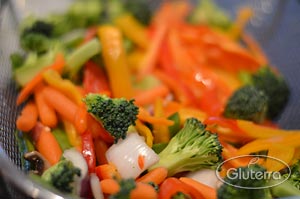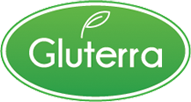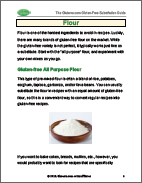Submitted by Kimberly on June 7, 2013
 So you're Gluten-free now, a change you're hoping will benefit your health, and possibly reverse any health problems you may be encountering. If you're experiencing anything like I did when I decided to become a vegan (FYI — I'm no longer a vegan), you're learning exactly how your body responds to everything. Sorry, everything does matter. You can't sneak anything past your system. Some of us have more leniency than others, but you cannot trick your body.
So you're Gluten-free now, a change you're hoping will benefit your health, and possibly reverse any health problems you may be encountering. If you're experiencing anything like I did when I decided to become a vegan (FYI — I'm no longer a vegan), you're learning exactly how your body responds to everything. Sorry, everything does matter. You can't sneak anything past your system. Some of us have more leniency than others, but you cannot trick your body.
When I decided to switch from vegan to gluten-free, one of the first things I noticed was less bloat. My clothes fit better, I was more regular. Because I had sworn off a scale for a number of years (a practice in which I no longer adhere to), I can't tell you exactly how much weight I've lost. From my late 20's to my mid-30's though, I can tell you I've gone from a size 10 or so to a size 6, sometimes even a 4 if I'm in super workout mode. Even friends of mine who aren't strict with their gluten intolerances definitely notice extra pounds when they've gone astray. When you eat something your body can't digest properly, it oftentimes spends way too much time in your system. Some of it just sits in your colon and large intestines. Sometimes 5 to 10 pounds of waste is just sitting in your body. Not good! Before going gluten-free, I had a terrible time maintaining a healthy weight. Starvation is not an option — I just love to eat too much. Fortunately, eliminating gluten has helped me tremendously.
In contrast, some people gain weight instead when they go gluten-free. There are a few reasons why this happens. I can't emphasize enough, you can't live your life eating packaged and processed foods and expect to be your healthiest. Open your pantry- what's in there? In mine you'll find mostly gluten-free pastas for my son, some spices, baking ingredients, dried beans, dried fruits and nuts. Boxes of gluten-free crackers and cereals for my son surface on occasion, but usually those are just for grab and go snacks. My son and I both prefer home-cooked meals. Eating processed foods can certainly contribute to weight gain. Also, sometimes a gluten-free food item is actually less nutritionally sound than a similar version. I'll use bread as a dominant example. The bread I used to buy before giving up gluten? Tons of protein and fiber (I'm all about the fiber). The choices I found that were — gluten free? Mostly starches. White rice is often the main ingredient in gluten-free bread, which is actually quite high on the glycemic index. Eating foods high on the glycemic index not only digest differently (it's not long-lasting fuel), but they often trigger cravings. Cravings often lead to over-eating, and usually it's the wrong foods (chips, crackers, sweets). I can't say it enough, sticking to whole foods closest to their original form (vegetables, legumes, whole grains), is the healthiest way to go.
 The main reason I decided to ditch the vegan diet (a diet in which I dedicated myself to for over 15 years) was because my son benefited greatly from a gluten-free, casein-free, soy-free diet. The soy part took me a little longer to realize, but my goodness did it make all the difference! For my son, soy breaches are every bit as bad, if not worse, as gluten or casein breaches. With that said, once I realized my tofu-loving, soy milk-drinking son had to avoid soy... I figured I needed to set the precedent and eat only things he could eat, at least for a while. Turns out I'm a bit sensitive to soy myself, especially if I eat tofu or meat-free sandwich slices. And gluten? Wow! I had no idea the bloating and irregularity it was causing me! I'm not as strict with my gluten-free diet as I am with my son's, but I always notice when I'm slacking!
The main reason I decided to ditch the vegan diet (a diet in which I dedicated myself to for over 15 years) was because my son benefited greatly from a gluten-free, casein-free, soy-free diet. The soy part took me a little longer to realize, but my goodness did it make all the difference! For my son, soy breaches are every bit as bad, if not worse, as gluten or casein breaches. With that said, once I realized my tofu-loving, soy milk-drinking son had to avoid soy... I figured I needed to set the precedent and eat only things he could eat, at least for a while. Turns out I'm a bit sensitive to soy myself, especially if I eat tofu or meat-free sandwich slices. And gluten? Wow! I had no idea the bloating and irregularity it was causing me! I'm not as strict with my gluten-free diet as I am with my son's, but I always notice when I'm slacking!
Our food is our fuel, right? We've all heard throughout our lives we have to give our bodies the right type of fuel for it to function properly. Judging by the consistent long lines at every fast food joint, it's no secret not everyone is striving for the healthiest diet. I'm going to assume though, if you're visiting the Gluterra site, you have a vested interest (whether it be by choice or by necessity) in eating properly. In this article I will focus on keeping a healthy gluten-free diet. Just because it's gluten-free doesn't mean it's healthy! Along the same lines- not everything at the health food store is healthy. Sure, if you have to have a lollipop I personally think it shouldn't contain artificial dyes and flavors, but candy is candy no matter who makes it.
Anyone who knows me thinks I'm the epitome of a health food nut. I have a heavily plant-based diet, avoid most processed foods, and am calorie conscious. When I feed my son though, I'm far more lenient, but I still want his food to have nutritional value to it. As a toddler, my son was finicky (shocking, right?). He ate too many starches, not enough vegetables... pretty typical of toddlers for the most part. When I bought him snacks I tried to buy him whole grain, I looked for fiber content, daily nutritional values. Going gluten-free though? There were so few options due the number of ingredients we needed to avoid, and so many of the options left had almost no nutritional value. I'll use bread as the primary example. There are some pretty power-packed breads on the market these days. Fiber, proteins, even flax, made the store-bought loaf far healthier. The loaf that contained 4 grams of fiber per serving soon took on the role of “contraband”, as it contained both soy and gluten ingredients.
When I first began shopping for my newly gluten-free, casein-free, soy-free son, I have to admit it was more out of desperation than anything. I was once used to buying something for him, and now I'm looking to buy the same thing- just a gluten-free, casein-free, soy-free version of it. Turns out, my options weren't very nutritional (based on my standards anyway), so I learned to create my own over the years. This, in turn, leads to my number one piece of advice- don't try to replicate everything. Like the 20 hours or so I spent in the kitchen trying to master ravioli for Andrew, it just wasn't worth my efforts. Not only did the results turn out inedible (with delectable being my goal), but some of the substitutes, such as pea flour, turned out to aggravate my son almost as much as the ingredients we were trying to avoid in the first place (in this case, soy).
Variety was definitely one of the first things I missed once starting gluten-free. Instead of 12 different labels, I was now left with 4. Out of those 4, I had to eliminate the brands that may cause a threat of cross-contamination (not every company has a dedicated factory). The choices I was left with? Either a dried out rice bread with little to no taste and no fiber, or a brown rice version (still with no taste), with one gram of fiber and little nutritional value.
Years later, although there are many more varieties than there once used to be, I chose to bake my own bread starting with a mix (currently the french bread/pizza crust from Gluten-free Pantry). When I bake my own bread, amongst other baked goods, I have almost complete control in the nutritional content of the food item. I own a bread maker with a gluten-free setting on it, so it's simple. And the smell of bread baking in my house — amazing. Currently, my son is accustomed to a loaf of bread baked fresh with zucchini, coconut, carrots, and flax seed in it. Far heartier than any store bought loaf I could find that meets his dietary restrictions.
 The same is true for muffins — a staple of my son's breakfast food and lunchbox options. He absolutely loves Namaste brand's muffin mix. As an over-informed mom, though, I feel I could always improve any mix or recipe. Like many gluten-free options, the base is rice flour. Although it's non-threatening to the digestive tract, I feel it could definitely be improved upon in regards to nutrients. Currently, my son very willingly shreds carrots and zucchini, and adds cinnamon and crushed blueberries (he has texture issues) to his muffin mix. In fact, he is usually the first to gather produce once he realizes we are about to prepare a baked good... he thinks carrots and zucchini are essential! What once began as a needed (i.e. desperate) replacement to one of the foods I relied on to feed my child, turned into a reliable and nutritional meal I could feel confident in feeding him. Did I start out the first month, or year, in realizing this? No. My son once ate the un-altered version of every food item and mix I could find. He consumed far too many starches and sugars, in my opinion, versus fiber content and nutritional value. Now, however, I know better.
The same is true for muffins — a staple of my son's breakfast food and lunchbox options. He absolutely loves Namaste brand's muffin mix. As an over-informed mom, though, I feel I could always improve any mix or recipe. Like many gluten-free options, the base is rice flour. Although it's non-threatening to the digestive tract, I feel it could definitely be improved upon in regards to nutrients. Currently, my son very willingly shreds carrots and zucchini, and adds cinnamon and crushed blueberries (he has texture issues) to his muffin mix. In fact, he is usually the first to gather produce once he realizes we are about to prepare a baked good... he thinks carrots and zucchini are essential! What once began as a needed (i.e. desperate) replacement to one of the foods I relied on to feed my child, turned into a reliable and nutritional meal I could feel confident in feeding him. Did I start out the first month, or year, in realizing this? No. My son once ate the un-altered version of every food item and mix I could find. He consumed far too many starches and sugars, in my opinion, versus fiber content and nutritional value. Now, however, I know better.
The same is true for cookies and cakes — I almost always add grated vegetables (usually carrots or zucchini because they've worked for so long), and I prefer to reduce the sugar... which means I'm usually baking my own. Adding fruits and cinnamon adds enough sweetness for my son to feel it's a “treat.” Why would I want to get him accustomed to the overly sweet products if he actually LIKES his desserts that have some wholesomeness? Because he tends to fight yeast overgrowth, I'm especially conscious of sugary treats.
Another go-to food for most anyone? Pasta. Noodles, ziti, elbows... almost everyone eats them, and there are so many to choose from... even when you're gluten-free!! Whole-heartedly I recommend Tinkyada pastas. I buy the brown rice (with rice bran versions). Some of them have up to 5 grams of protein, and 2 grams of fiber. Some of the pastas I try to avoid are usually corn-based — I don't feel corn has as much nutritional value as other options. Also, I prefer using brown rice versus white. I recently discovered an Organic Mung Bean Fettuchini (I spell it “fettuccine”, but they don't) by Explore Asian Authentic Cuisine that my son inhales! It has a whopping 20 grams of protein per serving, so I don't serve it with meat, fish or eggs. It's low in fiber (less than one gram per serving), so my son eats his with spinach or brocolli for balance.
Something I feel everyone, not just gluten-free folks, needs to realize is that whole foods tend to be far healthier than anything you'll find in a package. Granted, I'm the oddball who's content with a bag of raw veggies as a snack, but I realize there's compromises on any level. You want something sweet? I can usually have an apple and feel satiated, but perhaps some fruit with honey on top will suffice for you? Instead of grabbing a candy bar or ice cream? Try adding cocoa powder to some frozen coconut milk or frozen bananas and blend it until it resembles ice cream. An open mind has definitely gotten me through the past 8 years of gluten-free living. At first, I felt deprived. More importantly, I felt I was depriving my son. Years later though, I think it's safe to say we're both comfortable with our lifestyle. I encourage everyone to ask for help when first getting started on a gluten-free lifestyle! It's amazing how many of us there are. Once you get a few go-to recipes and products under your belt, you'll start to realize how to adapt things to suit your own taste or needs. I personally email shopping lists and recipes to anyone who asks, and wish everyone a successful and healthy journey.
- Login to post comments


 Click here to get a FREE GF Substitution Guide!
Click here to get a FREE GF Substitution Guide! 
 Sign-up to become a part of our gluten-free community. As a gift for being a free member, you can download our Gluten-Free Substitution Guide -- over 40 pages of great gluten-free substitutes. As a member, we will also send you our latest updates, recipes, and special offers. We'll try not to bug you and we won't share your info.
Sign-up to become a part of our gluten-free community. As a gift for being a free member, you can download our Gluten-Free Substitution Guide -- over 40 pages of great gluten-free substitutes. As a member, we will also send you our latest updates, recipes, and special offers. We'll try not to bug you and we won't share your info.